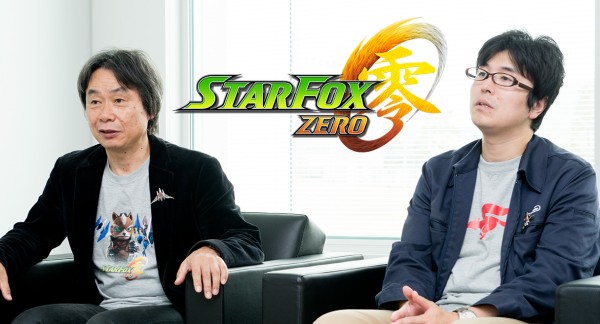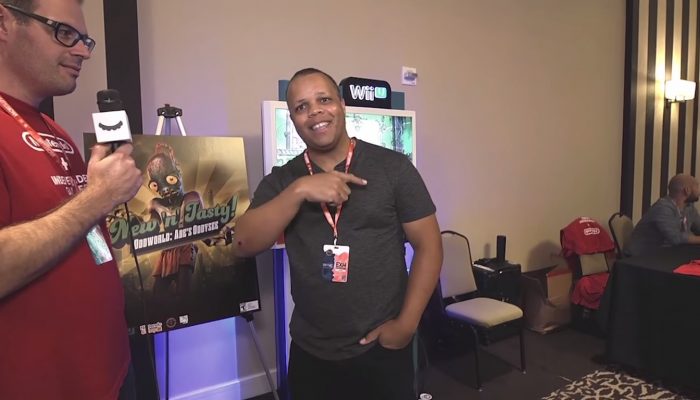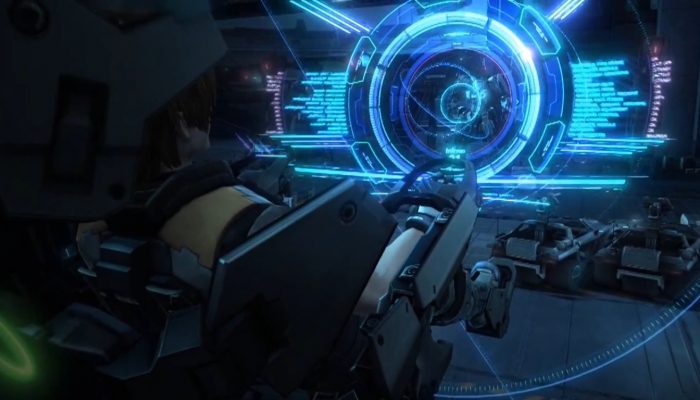 An interview pretty much twenty years in the making. 🙂
An interview pretty much twenty years in the making. 🙂
☆ NintendObs Weekly – Monday, May 9, 2016 – Sunday, May 15, 2016.
Star Fox Zero – Dev Team Interview: Part One, It’s Got to Feel Immersive and Look Cool
Learn about the making of Star Fox Zero in the first of our three-part developer interviews.
Version française ici : Star Fox Zero – Interview de l’équipe de développement : 1re partie, Il faut que ça ait l’air cool et que ce soit immersif. 😉
13/05/2016
Interviewees: Shigeru Miyamoto, Creative Fellow, Nintendo Senior Managing Director (Pictured left)
Yugo Hayashi, Game Director, Nintendo Entertainment Planning & Development Division (Pictured right)
Hello there! My name is Akinori Sao and I am a writer who set up the Japanese game magazine ’64 Dream’ (now known as ‘Nintendo DREAM’) pretty much exactly 20 years ago. I worked for many years as that publication’s chief editor before deciding to take a step back from the front line a few years ago. I’d always wanted to live in Kyoto, where Nintendo HQ is located, and ended up settling there where I became involved in books, magazines and websites while also keeping my hand in as a freelance writer – I suppose you could call me a gun for hire.
My latest order was to work on an interview with the team behind the Wii U title Star Fox Zero, which released on 22nd April in Europe. I went to Nintendo’s headquarters to speak with Shigeru Miyamoto, who worked as producer and supervising director on this game, along with the director, Yugo Hayashi, and asked them what had gone on behind the scenes during the game’s development.
This interview has been split into three parts: the theme of the first part is the need to ensure that the game both looked cool and had a really immersive feel. I asked the two directors how they had set out to realise their vision for the latest Star Fox title. Now let’s see what they had to say. Here goes!
Part One: It’s Got to Feel Immersive and Look Cool
The Importance of Voices in Star Fox
Sao: Star Fox 64(1) for the Nintendo 64 was released pretty much exactly 19 years ago. Miyamoto-san, you took part in a developer roundtable event at the Tokyo Game Show(2) as a special guest just before it was released. Do you recall that event?
Miyamoto: A roundtable event at Tokyo Game Show, you say? Really? Did that happen?
Sao: So you don’t remember it?
Miyamoto: Hmm. No, I can’t say that I do.
Sao: Well, that’s hardly surprising. It was 19 years ago after all! (laughs) In any case, after that roundtable event, I had the chance to interview you and we spoke about Star Fox 64.
Miyamoto: Right.
Sao: We spoke at first about the game’s difficulty level. I then mentioned that there was a lot of talking this time. When I said that, you responded by saying that you had indeed been talking a lot at the roundtable, and that it was probably because you were so excited. But you’d got the wrong end of the stick. What I meant is that the characters in the game talked a lot! (laughs)
Miyamoto: So it wasn’t me who was talking so much, it was the characters in Star Fox 64! (laughs)
Sao: That’s right! (laughs) The voiced lines are a really important element in the Star Fox titles. But at the same time, it was hardly unusual back then – there was a tendency for characters in games to talk a lot.
Miyamoto: Yes, you’re right. It was fashionable to use voice actors to give the characters spoken lines. But I personally thought that if the lines were repetitive or didn’t have much connection with what was going on in the game, it would be better not to have any spoken lines at all.
Sao: Sometimes you have to sit through lots of dialogue when you just want to get on with the game.
Miyamoto: Yes, but I think that in the case of Star Fox 64, the voices really work in the context of the game.
Sao: In a shooting game, you don’t have time to read text that might appear on the screen, but by using voiced lines, you can give the player hints and guide them towards the best strategy to follow.
Miyamoto: Right, and we wanted to get that information across in as few lines as possible. It’s a fast-paced game, so it’s really important that the lines are short and punchy. Having someone shouting, ‘Look up there!’ or, ‘There are enemies on our tail!’ also serves to up the excitement and makes the whole experience feel cooler for the player.
Sao: In a classic 3D shooter, it wouldn’t really be fair to have enemies coming up behind the player where they couldn’t see them, but if you have someone shouting ‘Look out behind you!’ it gives the player the chance to react accordingly.
Miyamoto: Right. By having other characters speak, it increases the scope of the action.
Sao: But even so, it’s pretty nasty of the enemy to sneak up behind you!
Miyamoto: Yes, but there’s nothing to stop you slamming on the brakes, flipping over in mid-air and blasting them before they get you! (laughs)
Sao: Ah, I see! So you’re giving them a taste of their own medicine. That’s Slippy’s style, isn’t it? (laughs)
It’s Like You’re Right There in the Cockpit
Sao: Hayashi-san, you worked as the director on this title, but when Star Fox 64 came out, you would have been…?
Miyamoto: You hadn’t been born yet, had you?
Hayashi: That’s not quite true! (laughs) I was a high school student, and I was really into Star Fox. I had the strategy guide and everything. I used to get all my friends over and we’d take part in battles together.
Sao: So as a high school student back then, what impression did you have of Star Fox 64?
Hayashi: At first I thought it might be a bit too difficult, but I realised pretty quickly that once you play a little, you get better and better. I remember how you’d be able to find better routes through a level, so you’d rack up a higher score, and before you knew it, you were completely absorbed in the action. I’d play every day and see what score I could get. That way, I’d be able to tell what kind of physical shape I was in at any given point.
Miyamoto: It turned out that you were much more of a Star Fox 64 expert than I was, which was a huge help! (laughs)
Hayashi: (laughs) You just spoke about the voices in the game, and I really think that even though it was a really fast-paced shooting game where the timing of attacks was really important, all those short vocal lines never interfered with the gameplay. They drew you deeper into the story and made it a more immersive and vibrant experience.
Sao: And that sense of being part of the action brings me on to the new system(3)employed in Star Fox Zero for the voiced lines. It really ups the realism and I was very surprised when I first heard it in action. It’s as if your allies and enemies are right there next to you…
Miyamoto: Yes, it feels strange, doesn’t it?
Sao: It really does. It’s as if you’re wearing a really high-end set of headphones.
Miyamoto: There are a lot of techniques you can use for stereophonic sound effects, but this one is really specific to this game. When you’re holding the Wii U GamePad, the speakers are a set distance from you, so it really does feel like someone’s whispering in your ear.
Hayashi: In this title, Fox McCloud is wearing a kind of visor that covers one eye, so by using this technique for the voices, you get the sense that you’re listening to the other characters via that headset.
Sao: Yes, it feels like you’re right there in the cockpit of the Arwing and that you’re really communicating with the other characters.
Miyamoto: We did things like having enemy voices come from the left speaker, and your allies’ voices from the right.
Hayashi: I think that we’ve really managed to ramp up the sense of realism in comparison with Star Fox 64.
I Wanted to See Something Cool
Sao: What originally motivated you to make a new Star Fox title?
Miyamoto: I wanted see something really cool.
Sao: What do you mean?
Miyamoto: When I was a kid, I would hold plastic models of aeroplanes and fly them right in front of my eyes, just like this… (twisting and turning his hand) I’d make the sound of the engines too.
Sao: So you’d pretend that you were flying the plane, right? (laughs)
Miyamoto: Yes, and as a kid playing like that, there’d be times I’d find something that looked so cool.
Sao: So you’d find an angle that you thought looked really great and that would make you happy.
Miyamoto: Right, and in this game, because we had both the TV and the Wii U GamePad screen, I wanted to have images shot from different angles both showing in real time.
That lets you do all sorts of experiments, like imagining you’re in the control tower flying a remote control plane, while at the same time you can see what the control tower looks like from the cockpit.
Sao: So you started off experimenting with the cameras.
Miyamoto: Yes, and then I’d find that it looked cooler watching from the control tower. It’s the same in a racing game. Obviously, while you’re playing, you see the action from the driving seat, but you’ll often find that the replays from different angles end up looking cooler, right?
Sao: Yes, I know what you mean.
Miyamoto: That’s why I decided I wanted to use the dual screen system of having both the Wii U GamePad and the TV, and have cool images of the Arwing flying shown on the TV, while the images from the cockpit were displayed on the Wii U GamePad screen.
Sao: And the Wii U GamePad’s motion controls also make it easier to target the enemy.
Miyamoto: That’s right. We’ve made it so the player is free to watch the action on the screen they prefer, depending on what’s going on at that point. It also lets anyone who’s watching you play enjoy really cool scenes. That’s how it came about – I thought, if I want to realise this vision, we’re really going to have to make a new Star Fox title for Wii U.
Sao: I see. And what scenes do you think look best, Hayashi-san?
Hayashi: Well, on the initial Corneria stage, there is an enemy boss, which is this huge battleship.
Sao: Ah yes. You take out its laser cannons one by one in order to defeat it.
Hayashi: Right, and if you fly below the battleship, there’s this moment when this broken piece of wreckage from the ship smashes into you, and I thought that was just really unfair.
Sao: So if you’re watching the action from the cockpit via the Wii U GamePad, you won’t know what’s hit you.
Hayashi: Yes, but if you watch it from the other angle you’ll be able to fly under the enemy ship, avoiding that flying piece of wreckage and it just looks so cool.
Miyamoto: Just because you’ve beaten the boss, it doesn’t mean you can just forget all about a stage. You’ll want to play the same stage again and again and work on finding your own personal cool scenes. That adds a whole new way to enjoy Star Fox this time round.
An Intuitive Control System
Sao: I believe that one of your goals during the development of this game was to make full use of the Wii U GamePad.
Miyamoto: Yes, that’s right. The two control sticks on the Wii U GamePad allow for really intuitive gameplay. In the N64 version, the braking and boost functions were triggered using buttons…
Hayashi: But this time round, you can boost your speed by pushing the right stick forward and brake by simply tilting it back towards you.
Sao: So that means you don’t have to worry about remembering which button the brake is. The controls are completely intuitive.
Miyamoto: Right. And in addition to the two sticks, you press the ZR Button to shoot and target enemies using the motion controls, which makes it all even more intuitive. It’s a really simple control system. The only other thing to think about is occasionally using the A Button to transform your ship.
Sao: Even so, listening to that, I think this might seem rather complicated to someone who has never played the game before.
Hayashi: Well, that’s why we’ve made it so you don’t have to go straight into battle if you don’t want to. You can give Training a go first.
Miyamoto: Ah, yes. If you do the training mode properly, everything will make sense and it will be easier to come up with strategies in battle.
Hayashi: For the training mode, we discussed whether or not we should allow the player to see every type of ship right from the start.
Sao: In the end, you’ve allowed the player to fly ships that feature in levels they won’t have reached yet.
Hayashi: Yes, we did.
Miyamoto: We were really in two minds about all this, but in the end we decided that it would be tricky to suddenly find yourself in a new ship in a later stage and not have the first clue how to fly it. Early in the game’s development, we’d kind of assumed that we wouldn’t need to explain how to fly the ships – players would just be able to get the hang of it. That’s why we put a line in the game saying something like, ‘The controls are fairly simple. I hope you enjoy giving it a try.’
Sao: So the idea was that you’d use that line when you first get in a new ship, right? (laughs)
Miyamoto: That’s right. But then right at the end of the development process, we created the training mode and that line slotted right into place. (laughs) Partway through development, we hadn’t quite known what to do with that line, but it turned out it was a good idea to have recorded it.
Sao: Right, that line sounds perfectly natural in the training mode.
Miyamoto: Right. And my advice to everyone who plays the game is to start off by doing the training mode.
Please look forward to the second and third instalments of this interview coming soon.
— Nintendo UK News
Source: Nintendo UK.
At NintendObserver, the comments are on Discord.
Click on Community to learn more. 🙂
…
…Wanna play? Buy a Wii U.
And if you’ve already got yours, click on Star Fox Zero for everything you need to know about the game. 😀









